The Katskhi Pillar in Georgia’s Imereti region was in focus in a BBC article. Author Priyanka Shankar described, “monks scale the 40m-high Katskhi Pillar in a daring, nerve-jangling ascent. The reason: to get closer to God.”
I had travelled 220km from Georgia’s capital Tbilisi to visit this soaring stone structure. I’d long been fascinated by the famous Greek monasteries of Meteora – which are also precipitously built on natural rock pillars – and when I’d heard of an extraordinary church where daring monks climb to be closer to heaven, I knew I had to visit.
Monks lived on top of the Katskhi Pillar for centuries; the last one only came down for good in 2015. Today, it’s a pilgrimage site for many Orthodox Christians, as well as a tourist attraction for people who flock here to here to witness the nerve-jangling sight of monks dangling off the steep rock edge.
Dedicated to a monk named Maximus the Confessor, the church is one of the world’s highest and most isolated churches. It is thought to have been built somewhere between the 6th and 8th Centuries by Stylites, or “pillar monks”, who believed that praying on top of pillars or high cliffs would distance them from worldly temptations.
Katskhi Pillar is one of the few remaining places where this extreme form of asceticism exists, albeit in a highly modified form.
Historians believe that monks started living on the pillar around the 10th Century, though they are still unsure how they reached the top, let alone carried the building materials to construct the church.
This pillar is the symbol of the true cross. Even before there was a church on top, idols of Gods have been found below the pillar.
Read the full article here
